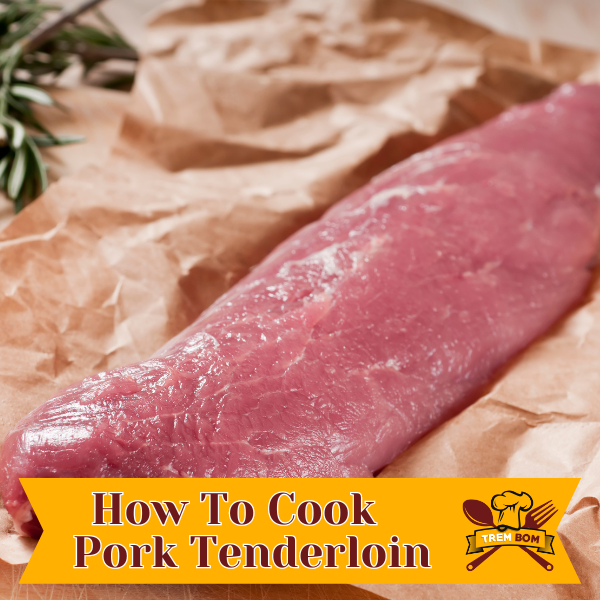
In this comprehensive guide, we will walk you through the process of cooking pork tenderloin to perfection. Whether you’re a beginner or an experienced home cook, these recipes and techniques will help you achieve a juicy and flavorful pork tenderloin every time. From understanding the difference between pork tenderloin and pork loin to mastering the best cooking methods, you’ll find all the information you need to create delicious pork tenderloin dishes. So, let’s dig in and explore the wonderful world of pork tenderloin!
Key Takeaways:
- Learn how to cook pork tenderloin to perfection with our comprehensive guide.
- Discover the difference between pork tenderloin and pork loin and make the right choice for your recipes.
- Understand the importance of timing and searing in cooking pork tenderloin.
- Master the techniques to make your pork tenderloin juicy and flavorful.
- Explore versatile cooking methods and try our delicious recipes.
Introduction to Pork Tenderloin
In this section, we will provide an introduction to pork tenderloin. We will first explain the difference between pork tenderloin and pork loin, as the two cuts are often confused. Understanding the characteristics of each cut will help you make the right choice for your recipes. Additionally, we will explore why pork tenderloin is such a popular choice among home cooks and professional chefs alike. Its tenderness, versatility, and mild flavor make it a beloved ingredient in various cuisines around the world.
Basic Techniques to Cook Pork Tenderloin
In this section, we will explore the basic techniques you need to know to cook pork tenderloin to perfection. Whether you’re a beginner or an experienced cook, understanding these techniques will help you achieve tender and flavorful results.
How Long to Cook Pork Tenderloin: Timing is Key
The cooking time for pork tenderloin depends on various factors, such as the weight of the cut and the desired level of doneness. It’s essential to cook pork tenderloin for the right amount of time to ensure it’s cooked through but still juicy and tender.
To determine the cooking time, it’s best to use an instant-read meat thermometer. The USDA recommends cooking pork tenderloin to an internal temperature of 145°F (63°C) with a three-minute rest time for optimal safety and quality.
Here is a general guideline for the cooking time of pork tenderloin:
| Pork Tenderloin Weight | Cooking Time |
|---|---|
| 1 pound (0.45 kg) | Approximately 20-25 minutes |
| 2 pounds (0.9 kg) | Approximately 25-30 minutes |
| 3 pounds (1.36 kg) | Approximately 30-35 minutes |
It’s important to note that these times are just estimates, and cooking times can vary depending on factors such as oven temperature and the thickness of the tenderloin. Always use a thermometer to ensure the pork is cooked to the desired doneness.
To Sear or Not to Sear Pork Tenderloin
Searing pork tenderloin before cooking is a technique that can enhance the flavor and texture of the meat. Searing creates a delicious caramelized crust on the outside while locking in moisture.
However, whether to sear or not is a matter of personal preference and the specific recipe you’re using. Here are some factors to consider when deciding whether to sear your pork tenderloin:
- Flavor: Searing can add a rich, savory flavor to the meat, thanks to the Maillard reaction that occurs during the browning process.
- Texture: Searing can help create a crispy exterior while keeping the inside juicy and tender.
- Time: Searing adds an extra step to the cooking process, which may not be ideal if you’re short on time.
- Recipe: Some recipes specifically call for seared pork tenderloin to achieve a certain flavor profile or presentation.
Ultimately, whether to sear or not sear your pork tenderloin is up to you. Experiment with both methods to see which one you prefer and which works best for the recipe you’re preparing.
Mastering the Best Pork Tenderloin Recipe
The Secret to a Juicy Pork Tenderloin
When it comes to cooking pork tenderloin, the secret to achieving a juicy and flavorful result lies in the right techniques and ingredients. Our favorite pork tenderloin recipe has been crafted to perfection, ensuring a succulent and moist texture that will leave your taste buds wanting more.
One key element to making a juicy pork tenderloin is the preparation process. Before cooking, it’s important to marinate the tenderloin. This helps to infuse the meat with delicious flavors while also tenderizing it. Our recipe uses a combination of herbs, spices, and a splash of citrus for an irresistible taste.
Making Your Tenderloin Juicy: Tips and Tricks
In addition to the marinade, there are a few tips and tricks that can help you achieve the juiciest pork tenderloin ever:
- Brining: Consider brining the pork tenderloin before cooking. This involves soaking it in a mixture of water, salt, and sugar, which helps to lock in moisture and enhance the tenderness.
- Using a meat thermometer: Cooking pork tenderloin to the right internal temperature is crucial for a juicy result. Use a meat thermometer to ensure it reaches an internal temperature of 145°F (63°C) for medium-rare or 160°F (71°C) for medium.
- Resting time: After cooking, allow the pork tenderloin to rest for at least 5 minutes before slicing. This allows the juices to redistribute throughout the meat, resulting in a more flavorful and moist tenderloin.
By following these tips and tricks, you can elevate your pork tenderloin cooking game and create a dish that will truly impress your guests. Get ready to savor every juicy and flavorful bite!
Versatile Cooking Methods
When it comes to cooking pork tenderloin, there are a variety of versatile methods that can be used to create delicious and flavorful dishes. In this section, we will explore two popular cooking methods: roasting and baking. Whether you prefer a classic approach or a more convenient and easy method, these techniques will help you achieve tender and juicy pork tenderloin every time.
Roast Pork Tenderloin: A Classic Approach
Roasting is a classic method of cooking pork tenderloin that results in a beautifully browned exterior and tender, succulent meat. To roast pork tenderloin, follow these simple steps:
- Preheat your oven to the recommended temperature.
- Season the pork tenderloin with your favorite herbs and spices.
- Place the seasoned tenderloin on a baking rack set inside a roasting pan.
- Roast the pork tenderloin in the preheated oven until it reaches the desired internal temperature.
- Remove the tenderloin from the oven and let it rest for a few minutes before slicing and serving.
Roasting pork tenderloin is a great option when you want to showcase the natural flavor of the meat and achieve a caramelized crust. It pairs well with a variety of side dishes and sauces, making it a versatile choice for any occasion.
Baked Pork Tenderloin Recipe for Easy Cooking
If you’re looking for a simpler and more convenient cooking method, baking pork tenderloin is a great option. With just a few ingredients and minimal preparation, you can create a delicious and satisfying meal. Here’s a baked pork tenderloin recipe to try:
“This baked pork tenderloin recipe is perfect for busy weeknights. With minimal prep and hands-off cooking time, you can have a flavorful and tender pork tenderloin on the table in no time.”
| Ingredients | Instructions |
|---|---|
| 1 pork tenderloin Salt and pepper, to taste Your favorite herbs and spices | Preheat your oven to the recommended temperature. Season the pork tenderloin with salt, pepper, and your favorite herbs and spices. Place the seasoned tenderloin on a baking sheet lined with foil. Bake the pork tenderloin in the preheated oven until it reaches the desired internal temperature. Remove the tenderloin from the oven and let it rest for a few minutes before slicing and serving. |
This baked pork tenderloin recipe is incredibly versatile and can be customized with your favorite seasonings. It’s a fuss-free option that delivers mouthwatering results, making it perfect for busy schedules or when you want to simplify your cooking process.
Whether you choose to roast or bake your pork tenderloin, both methods will result in a delicious and satisfying meal. Feel free to experiment with different flavors and seasonings to find your favorite way of preparing this versatile cut of meat.
Advanced Pork Tenderloin Recipes
In this section, we will take your pork tenderloin cooking skills to the next level with advanced recipes. We understand that you’re looking to elevate your pork tenderloin dishes to new heights, and we’ve got just the recipes for you. Prepare to impress your family and friends with these mouthwatering creations.
The Juiciest Roasted Pork Tenderloin Recipe
If you’re looking for a foolproof way to achieve a juicy and tender pork tenderloin, our roasted pork tenderloin recipe is just what you need. With the perfect balance of flavors and a cooking method that locks in the moisture, this recipe guarantees succulent results every time.
“This roasted pork tenderloin recipe is absolutely amazing! The meat is incredibly tender and juicy, and the flavors are out of this world. It’s definitely a crowd-pleaser!” – Jane, Home Cook
To make our roasted pork tenderloin, you’ll need:
- 1 pork tenderloin (approximately 1 pound)
- 2 tablespoons olive oil
- 1 tablespoon fresh rosemary, chopped
- 1 tablespoon fresh thyme, chopped
- 2 cloves garlic, minced
- Salt and pepper to taste
Preheat your oven to 425°F (220°C) and follow these simple steps:
- In a small bowl, mix together the olive oil, rosemary, thyme, garlic, salt, and pepper.
- Rub the mixture all over the pork tenderloin, ensuring it is evenly coated.
- Place the seasoned tenderloin on a baking sheet and roast in the preheated oven for about 20-25 minutes or until the internal temperature reaches 145°F (63°C).
- Remove the pork from the oven and let it rest for 5 minutes before slicing and serving.
Enjoy the juiciest roasted pork tenderloin that is packed with flavors and sure to impress!
Exploring Different Flavors in Pork Tenderloin Recipes
While a perfectly roasted pork tenderloin is delicious on its own, why not explore different flavor profiles to create unique and exciting dishes? Let’s dive into the world of pork tenderloin flavors and discover some mouthwatering combinations.
Here are some flavor variations you can experiment with:
| Flavor Profile | Ingredients |
|---|---|
| Asian-Inspired | Soy sauce, ginger, garlic, sesame oil |
| Mediterranean | Olive oil, lemon, oregano, garlic |
| Spicy | Chili powder, cayenne pepper, paprika |
| Sweet and Savory | Maple syrup, Dijon mustard, garlic |
| Herb-Infused | Rosemary, thyme, sage, garlic |
Feel free to mix and match these flavors or create your own unique combinations. The possibilities are endless when it comes to exploring flavors in pork tenderloin recipes. Let your taste buds guide you and have fun experimenting!
Quick and Easy Pork Tenderloin Dishes
In this section, we will provide quick and easy pork tenderloin recipes for those who are short on time. Our goal is to help you create delicious pork tenderloin dishes without sacrificing flavor or quality. With these simple recipes, you can whip up a satisfying meal in no time.
Easy Pork Tenderloin: Simple and Delicious
If you’re looking for a no-fuss pork tenderloin recipe that delivers on taste, we’ve got you covered. Our easy pork tenderloin recipe requires minimal ingredients and effort, making it perfect for busy schedules. The tenderloin is seasoned with a blend of herbs and spices, then cooked to juicy perfection. The result is a flavorful and tender dish that will impress your family and friends.
How to Make This Recipe Work for Busy Schedules
We understand that life can get hectic, and finding time to cook a full meal can be challenging. That’s why we’ve included tips on how to make this recipe work for busy schedules. By utilizing meal prep and time-saving techniques, you can streamline the cooking process and have a delicious pork tenderloin dish on the table in no time.
Here are some tips to help you make this recipe work for your busy schedule:
- Prep the ingredients in advance: Chop your herbs, measure out your spices, and marinate the pork tenderloin the night before or in the morning. This will save you time when it’s time to cook.
- Use a slow cooker or Instant Pot: These kitchen appliances are a lifesaver for busy individuals. You can set it and forget it, allowing the pork tenderloin to cook slowly while you focus on other tasks.
- Double the recipe and freeze leftovers: Cooking in larger batches not only saves time but also provides leftovers for future meals. Simply freeze the extra cooked pork tenderloin and use it in sandwiches, salads, or stir-fries on days when you’re in a rush.
- Invest in time-saving kitchen tools: Having the right tools can make a world of difference. Consider investing in a good quality meat thermometer to ensure your pork tenderloin is cooked to perfection without any guesswork.
By implementing these tips, you can enjoy a flavorful pork tenderloin dish even when you’re pressed for time. So, let’s get cooking!
| Ingredient | Quantity |
|---|---|
| Pork tenderloin | 1 pound |
| Olive oil | 2 tablespoons |
| Garlic powder | 1 teaspoon |
| Paprika | 1 teaspoon |
| Dried thyme | 1 teaspoon |
| Salt | 1/2 teaspoon |
| Black pepper | 1/2 teaspoon |
Instructions:
- Preheat your oven to 400°F (200°C).
- In a small bowl, mix together the garlic powder, paprika, dried thyme, salt, and black pepper.
- Rub the spice mixture all over the pork tenderloin, ensuring it is evenly coated.
- Heat the olive oil in an oven-safe skillet over medium-high heat.
- Place the pork tenderloin in the skillet and sear each side for 2-3 minutes, until nicely browned.
- Transfer the skillet to the preheated oven and roast for 15-20 minutes, or until the internal temperature reaches 145°F (63°C) for medium doneness.
- Remove the pork tenderloin from the oven and let it rest for 5 minutes before slicing.
- Serve the juicy and flavorful pork tenderloin with your favorite sides or use it as a filling for sandwiches or wraps.
There you have it – an easy pork tenderloin recipe that fits perfectly into your busy schedule. Enjoy!
Making the Most of Leftovers
In this section, we will explore creative ideas for utilizing leftover pork tenderloin and transforming it into delicious new dishes. Leftovers can often be the foundation for incredible meals, and with a bit of creativity, you can elevate your leftover pork tenderloin into something truly special.
Creative Ideas for Leftover Pork Tenderloin
When it comes to repurposing leftover pork tenderloin, the possibilities are endless. Here are a few creative ideas to inspire you:
- Create a savory pork tenderloin salad by tossing thinly sliced leftover tenderloin with fresh greens, your favorite vegetables, and a tangy vinaigrette.
- Make a hearty pork tenderloin sandwich by layering thinly sliced tenderloin on crusty bread with your favorite condiments and toppings.
- Turn your leftover pork into a stir-fry by sautéing it with colorful vegetables and a flavorful sauce. Serve it over rice or noodles for a complete meal.
- Transform your pork tenderloin into a delicious pasta dish by combining it with cooked pasta, sautéed garlic, mushrooms, and a creamy sauce.
Transforming Leftovers into New Dishes
When it comes to transforming leftovers, there are a few key tips to keep in mind:
- Properly store leftover pork tenderloin in an airtight container or wrap it tightly in foil before refrigerating.
- When reheating leftovers, be careful not to overcook the pork, as it can become dry. Reheat it gently in the oven or on the stovetop to maintain its flavor and moisture.
- Experiment with different spices, herbs, and sauces to add new flavors to your leftover pork tenderloin dishes.
- Consider incorporating your leftover pork into dishes from different cuisines to explore new flavor profiles and culinary traditions.
By getting creative with your leftover pork tenderloin, you can enjoy exciting and flavorful meals while minimizing food waste. So the next time you have some leftover pork tenderloin, don’t let it go to waste—transform it into something delicious!
Conclusion: Your Path to the Best Pork Tenderloin
In conclusion, mastering the art of cooking pork tenderloin is within your reach. Throughout this article, we have explored various techniques, recipes, and tips to help you achieve the best possible results when cooking pork tenderloin. By understanding the key points and implementing the strategies shared, you will be able to create juicy, flavorful, and tender pork tenderloin dishes that will impress your loved ones and elevate your culinary skills.
Recap: Key Points to Remember for the Best Pork Tenderloin
- Choose the right cut: Differentiate between pork tenderloin and pork loin to ensure you select the appropriate cut for your recipe.
- Timing is key: Understand the cooking time required for your desired level of doneness, whether it’s medium-rare or well-done.
- Consider searing: Searing pork tenderloin can enhance the texture and flavor, but it may not always be necessary.
- Focus on juiciness: Use techniques like brining, marinating, and proper resting to achieve a moist and succulent pork tenderloin.
- Experiment with flavors: Explore different marinades, rubs, and seasonings to add depth and variety to your pork tenderloin dishes.
Encouragement to Try and Make Your Own Pork Recipe
Now that you are equipped with the knowledge and techniques to create the best pork tenderloin, we encourage you to unleash your creativity and experiment with your own pork recipes. Don’t be afraid to try new flavors, methods, and cooking styles. Remember, cooking is a form of self-expression, and your unique twist can result in mouthwatering dishes that reflect your personal taste and culinary flair.
So, roll up your sleeves, gather your ingredients, and embark on a delicious journey with pork tenderloin as your guide. Whether you’re cooking for yourself, your family, or hosting a special event, the possibilities are endless. With practice, passion, and the guidance provided in this article, you’ll soon be able to confidently prepare the best pork tenderloin meals that will delight and satisfy even the most discerning palates.
Thank you for joining us on this pork tenderloin adventure. We hope you’ve enjoyed the journey, learned valuable techniques, and feel inspired to create your own culinary masterpieces. Happy cooking and bon appétit!
How To Cook Pork Tenderloin FAQ
In this FAQ section, we will address commonly asked questions about cooking pork tenderloin. We understand that achieving the perfect pork tenderloin can sometimes be a challenge, so we’re here to provide expert advice and clear any confusion you may have. Let’s dive into these frequently asked questions to ensure you have all the information needed to cook pork tenderloin to perfection.
What is the best method of cooking pork tenderloin?
The best method of cooking pork tenderloin depends on your preferences and the desired outcome. You have several options, including roasting, grilling, and pan-searing. Each method offers its own unique flavors and textures. It’s important to consider factors such as time, equipment availability, and personal taste when choosing the best method for you.
Is it better to cook a pork tenderloin at 350 or 400?
When it comes to cooking temperature, both 350°F and 400°F can yield delicious results. Cooking at 350°F will result in a slower and more gentle cooking process, while cooking at 400°F will provide a faster and slightly more intense cooking experience. The choice ultimately depends on your desired cooking time and the texture you want to achieve.
Should I sear my pork tenderloin before cooking it?
Searing pork tenderloin before cooking it can enhance the flavor and texture of the final dish. The high heat creates a beautiful crust that locks in the juices and adds depth to the overall taste. However, searing is optional and depends on personal preference. If you prefer a simpler cooking process, you can skip this step and still achieve delicious results.
Is it better to cook pork tenderloin covered or uncovered?
Whether to cook pork tenderloin covered or uncovered depends on the cooking method you choose. In general, covering the tenderloin with foil or a lid can help retain moisture and ensure even cooking. However, if you’re looking for a crispy exterior, cooking uncovered can create a delicious crust. Consider your desired outcome and the specific recipe instructions to determine whether to cook covered or uncovered.
Is it better to cook pork tenderloin fast or slow?
Cooking pork tenderloin fast or slow depends on the technique you prefer and the time you have available. Fast cooking methods like grilling or pan-searing offer quick results with a slightly caramelized exterior. Slow cooking methods like roasting can result in a tender and juicy interior. Both methods can produce delicious pork tenderloin dishes, so choose based on your preferences and time constraints.
How do you keep pork tenderloin moist?
To keep pork tenderloin moist, there are a few key tips to follow. First, avoid overcooking the meat, as it can dry out. Use a meat thermometer to ensure the pork reaches the recommended internal temperature without surpassing it. Another tip is to marinate the tenderloin before cooking to add flavor and moisture. Finally, resting the cooked tenderloin for a few minutes before slicing allows the juices to redistribute, resulting in a more moist and flavorful meat.
How long should pork tenderloin sit before cooking?
The ideal resting time for pork tenderloin before cooking is around 15 to 30 minutes. Allowing the meat to sit at room temperature before cooking ensures more even cooking and prevents the pork from being too cold in the center when it hits the heat source. This rest time also helps the meat retain juices for a more succulent result. However, be mindful of food safety guidelines and do not leave the meat out for an extended period.
FAQ
What is the best method of cooking pork tenderloin?
There are several great methods for cooking pork tenderloin, including roasting, grilling, and baking. Ultimately, the best method depends on your personal preference and the flavors you want to achieve.
Is it better to cook a pork tenderloin at 350 or 400 degrees?
It is generally recommended to cook pork tenderloin at a higher temperature, around 400 degrees Fahrenheit, to ensure that it cooks evenly and develops a flavorful crust. However, cooking at 350 degrees is also a viable option if you prefer a slower cooking process.
Should I sear my pork tenderloin before cooking it?
Searing pork tenderloin before cooking it can help enhance the flavor and texture of the meat. By quickly browning the exterior, the tenderloin develops a delicious caramelized crust that adds depth to the overall dish. However, searing is optional, and you can still achieve a juicy and flavorful pork tenderloin without this step.
Is it better to cook pork tenderloin covered or uncovered?
It is generally recommended to cook pork tenderloin uncovered, as this allows for better caramelization and a more flavorful crust. Cooking the tenderloin uncovered also helps it cook more evenly and prevents it from becoming too moist or soggy.
Is it better to cook pork tenderloin fast or slow?
Cooking pork tenderloin at a higher temperature for a shorter amount of time is usually the preferred method. This helps to lock in the juices and prevent the tenderloin from becoming dry. However, cooking pork tenderloin slowly at a lower temperature, such as in a slow cooker, can also yield tender and delicious results.
How do you keep pork tenderloin moist?
To keep pork tenderloin moist, it is important not to overcook it. Overcooking can lead to dry and tough meat. Additionally, marinating the tenderloin before cooking can help infuse it with flavor and moisture. Another tip is to let the cooked pork tenderloin rest for a few minutes before slicing. This allows the juices to redistribute, resulting in a more moist and flavorful final product.
How long should pork tenderloin sit before cooking?
It is best to let pork tenderloin sit at room temperature for about 20-30 minutes before cooking. This allows the meat to come to a more even temperature, ensuring more uniform cooking and juicier results.






